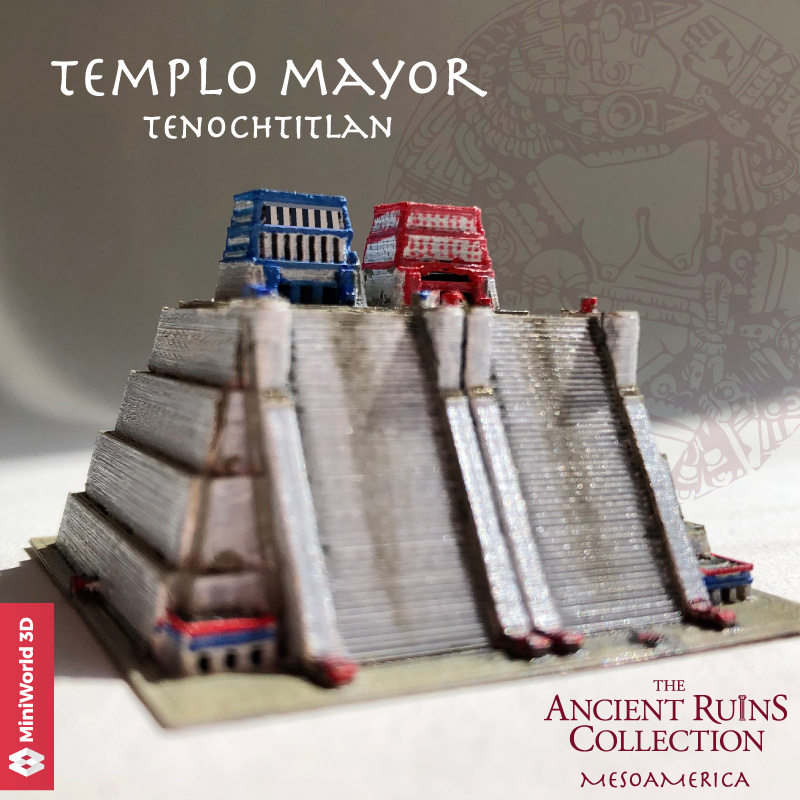
Templo Mayor - Tenochtitlan ( Mexico City )
prusaprinters
<p><strong>Welcome to Mexico City!</strong></p><p><strong>The Ancient Ruins Collection - Mesoamerica </strong>is a dedicated subcollection to the legacy of past civilizations in parts of what is present-day Mexico and Central America.</p><p>This model was designed by <a href="https://www.printables.com/social/15573-dany-sanchez/about">Dany Sánchez</a>.</p><p>The <strong>"Templo Mayor"</strong> (Spanish for<i> Great Temple</i>) was the largest and most important building in the ancient city of <strong>Tenochtitlán</strong>, which today is <strong>Mexico City</strong>.</p><p>Tenochtitlán was the capital of the Mexica (Aztec) Empire, a magnificent city built on islets on Lake Texcoco, in the Anáhuac basin in central Mexico. At the time of the arrival of the Spanish in 1519, it was more populous than London. </p><p>This model contains only the <strong>hypothetical</strong> <strong>reconstruction</strong> based on several accounts by first Spanish witnesses and chronicles. No ruins model is provided as the remains today are mostly unrecognizable, the pyramid being razed to the ground by Conquistadors.</p><p>The Temple was called <i>Huēy Teōcalli</i> (Great Temple) in the Nahuatl language. It was dedicated to both <strong>Huitzilopochtli</strong>, god of war and the sun (right), and <strong>Tlaloc</strong>, god of rain and agriculture (left), each of which had a shrine at the top of the pyramid with separate staircases. It was built in the exact location where Mexica legend says an <strong>eagle devoured a snake atop a nopal cactus</strong>, marking the location mandated by Huitzilopochtil to found their city (an illustration of this legend appears today in the Flag of Mexico).</p><p>The pyramid measured approximately 100 by 80 m (328 by 262 ft) at its base. It was built and expanded on six occasions, the first being sometime around 1325, and finally destroyed by the Spanish in 1521 to make way for the new Catholic cathedral of the newly founded Mexico City.</p><p>The recounts of <strong>Fray Bernardino de Sahagún</strong>, a Spanish missionary, describe braziers with sacred fires burning continuously in front of each shrine, and tall staircases with balustrades ending in snake heads. The whole building was covered in stucco and painted.</p><p>As mentioned before, this pyramid was the main building of the <strong>Sacred Precinct</strong>, a walled citadel within the city of Tenochtitlán reserved for temples, palaces, and other religious, government, military and education important buildings. All of these were razed and the Spanish-founded Mexico City was built on top, in European style, reusing the materials.</p><p>The location of the temple was forgotten until the 20th Century, when excavations slowly brought the remains back to light. A carved, circular stone depicting dismembered goddess <strong>Coyolxauhqui</strong> was found in 1978 in front of what used to be the staircase leading up to the temple of Huitzilopochtli (right shrine). It was up there where human sacrifices were conducted and bodies tossed rolling down the stairs to land dismembered exactly where the goddess did, recreating the myth of the birth of Huitzilopochtli and his victory over her envious sister Coyolhauhqui. In 1987, the Museum of the Templo Mayor opened to house all the findings <i>(</i><a href="https://en.wikipedia.org/wiki/Templo_Mayor"><i>from Wikipedia</i></a><i>).</i></p><p>MiniWorld 3D is excited to bring this historical model to life as a homage to all the people of Mexico. This model was created from scratch by hand and brain in parametric software to ensure printability, using photographs and blueprints to create a beautiful and stylized version of your favorite landmarks. Please give credit, it's all about spreading culture! </p><p>Be sure to follow us:</p><p><a href="https://www.instagram.com/miniworld3d/">instagram.com/miniworld3d</a></p><p><a href="https://www.instagram.com/ldibarra/">instagram.com/ldibarra</a></p><p><strong>MiniWorld 3D</strong> is a collective of 45+ artists creating the best library of 3D printable models of landmarks of the world!</p><p> </p><p><i>Photo credits: prints in Plasticz Netherlands metallic grey, 0.2mm. Hand painted models in acrylics by Dany Sánchez - except for one photo (that doesn't look like the rest), printed by </i><a href="https://www.instagram.com/swrv_manny/"><i>Emanuel Arana </i></a><i>and hand painted by </i><a href="https://www.instagram.com/nikkimelecrafts/"><i>Nikki Mele Crafts</i></a><i>.</i><br><br><i>Real location photo credit: </i><a href="https://creativecommons.org/licenses/by-sa/4.0/legalcode"><i>CC BY-SA 4.0</i></a><i> </i><a href="http://www.mikepeel.net/"><i>Mike Peel</i></a></p><p><i>-----------</i></p><h4><strong>Printing Tips</strong></h4><p>Suggested parameters:</p><p>For better details, print slow, such as 15 or 20mm/s for outer perimeters.<br>Fine-tune retraction to avoid stringing.<br>Perimeters: 2<br>Top layers: 3<br>Infill: as low as 12%<br><br>No supports needed, this has been optimized to eliminate all overhangs.</p>
With this file you will be able to print Templo Mayor - Tenochtitlan ( Mexico City ) with your 3D printer. Click on the button and save the file on your computer to work, edit or customize your design. You can also find more 3D designs for printers on Templo Mayor - Tenochtitlan ( Mexico City ).
